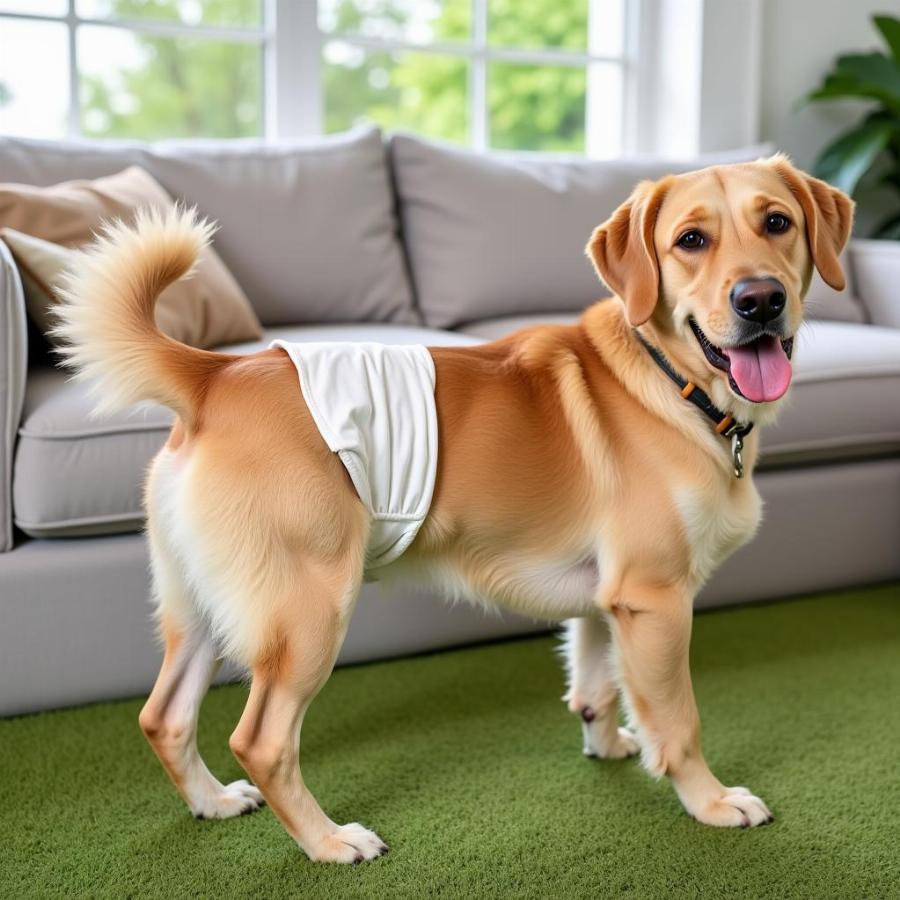Large female dog diapers are essential for managing incontinence, heat cycles, and other situations requiring hygiene management in larger breeds. Choosing the right diaper and ensuring a comfortable fit is crucial for your dog’s well-being. This guide provides everything you need to know about selecting, using, and caring for large female dog diapers.
Understanding the Need for Large Female Dog Diapers
 Large female dog wearing a diaper comfortably.
Large female dog wearing a diaper comfortably.
Why might your large female dog need diapers? Several reasons include urinary incontinence due to age, illness, or spay surgery; managing messy heat cycles; and post-surgery care. For senior dogs, diapers provide comfort and dignity, while for younger dogs, they can protect your home during heat. Choosing the correct size and type is essential for effectiveness and your dog’s comfort.
Choosing the Right Diaper for Your Large Female Dog
Selecting the right diaper involves considering your dog’s size, the reason for diapering, and the diaper’s features. Measure your dog’s waist and refer to the manufacturer’s size chart. Consider big dog diapers for extra-large breeds. Disposable diapers offer convenience, while washable reusable dog pads are eco-friendly and cost-effective in the long run. Look for features like leak-proof barriers, comfortable materials, and a secure fit.
Sizing and Fit: A Critical Aspect
Proper sizing is paramount for comfort and effectiveness. A diaper that’s too tight can restrict movement and cause chafing, while a loose diaper can lead to leaks. Always measure your dog’s waist carefully and compare it to the size chart provided by the manufacturer. Don’t hesitate to try different brands to find the perfect fit for your furry friend.
Putting on the Diaper: A Step-by-Step Guide
- Gather your supplies: diaper, treats (for positive reinforcement).
- Calm your dog and speak reassuringly.
- Position the diaper under your dog’s tail, ensuring the absorbent part is positioned correctly.
- Bring the diaper up and around your dog’s waist.
- Secure the fasteners snugly, ensuring the diaper is not too tight.
- Reward your dog with treats and praise.
Caring for Your Diapered Dog
Regularly check the diaper for soiling and change it as needed, typically every 4-6 hours. Clean the area around the diaper with a gentle pet-safe wipe. Monitor for any skin irritation or discomfort. If using washable diapers, follow the manufacturer’s instructions for washing and drying.
Keeping Your Dog Comfortable in Diapers
While diapers are necessary, ensuring your dog’s comfort is key. Choose breathable materials and avoid diapers that are too tight. Regular breaks from the diaper can prevent skin irritation. Positive reinforcement with treats and praise can help your dog associate the diaper with positive experiences. If your dog is experiencing a heat cycle, consider dog period nappies specifically designed for this purpose.
Conclusion
Large female dog diapers are a valuable tool for managing a variety of needs. Choosing the correct size, type, and practicing proper care will ensure your dog’s comfort and hygiene. By understanding the different options available and following these guidelines, you can make diapering a positive experience for both you and your furry companion. Remember to consider dog diapers for male dogs if you also have a male of a dog needing similar care.
FAQ
- How often should I change my dog’s diaper? Every 4-6 hours, or as needed.
- Can my dog sleep in a diaper? Yes, but ensure it fits correctly and is changed before bedtime.
- Are washable diapers better than disposable ones? Both have pros and cons; washable diapers are eco-friendly, while disposable ones are more convenient.
- What if my dog keeps trying to remove the diaper? Ensure a proper fit and use positive reinforcement. A veterinarian can also offer advice.
- How can I prevent diaper rash? Regular changing, gentle cleaning, and diaper-free breaks can help.
- Can I use human diapers on my dog? No, they are not designed for canine anatomy and can be dangerous.
- Where can I buy large female dog diapers? Pet stores, online retailers, and veterinary clinics.